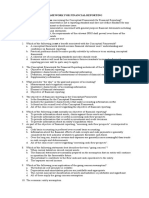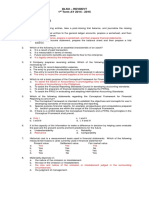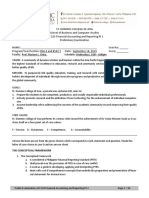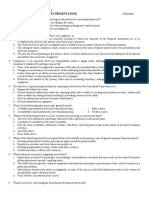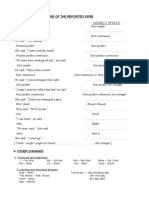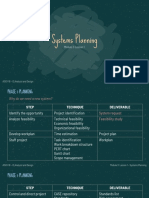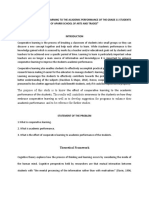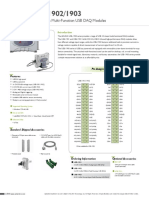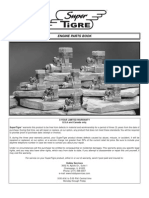0 ratings0% found this document useful (0 votes)
20 views2 Revised Conceptual Framework
2 Revised Conceptual Framework
Uploaded by
LINDAS XEROXCopyright:
© All Rights Reserved
Available Formats
Download as DOCX, PDF, TXT or read online from Scribd
2 Revised Conceptual Framework
2 Revised Conceptual Framework
Uploaded by
LINDAS XEROX0 ratings0% found this document useful (0 votes)
20 views3 pagesOriginal Title
2-revised-conceptual-framework
Copyright
© © All Rights Reserved
Available Formats
DOCX, PDF, TXT or read online from Scribd
Share this document
Did you find this document useful?
Is this content inappropriate?
Copyright:
© All Rights Reserved
Available Formats
Download as DOCX, PDF, TXT or read online from Scribd
Download as docx, pdf, or txt
0 ratings0% found this document useful (0 votes)
20 views3 pages2 Revised Conceptual Framework
2 Revised Conceptual Framework
Uploaded by
LINDAS XEROXCopyright:
© All Rights Reserved
Available Formats
Download as DOCX, PDF, TXT or read online from Scribd
Download as docx, pdf, or txt
You are on page 1of 3
Saint Ferdinand College
College of Accountancy
Integrated Course in Financial Accounting and Reporting
Handout – 2
Revised Conceptual Framework
1. What is the authoritative status of the Conceptual Framework?
a. The conceptual framework has the highest level of authority.
b. In the absence of a Standard, the Conceptual Framework should be followed.
c. In the absence of a Standard or an Interpretation that specifically applies to a transaction, management should
consider the Conceptual Framework in developing an accounting policy that results in relevant and reliable
information.
d. The conceptual framework applies only when new or revised standards are developed.
2. The Conceptual Framework is intended to establish
a. Accounting standard in financial reporting
b. The meaning of “present fairly in accordance with GAAP”
c. The objectives and concepts for use in developing financial accounting standards.
d. The hierarchy of sources of GAAP
3. Which is not a purpose of the Revised Conceptual Framework?
a. To assist the IASB to develop IFRS based on consistent concepts.
b. To assist preparers to develop consistent accounting policy when no standard applies to a particular transaction or
when Standard allows a choice of accounting policy.
c. To assist all parties to understand and interpret the Standards.
d. To assist the BOA in issuing rules and regulations affecting the accountancy profession.
4. What is the primary objective of financial reporting?
a. To provide economic information that is comprehensible to all users.
b. To provide management with an accurate evaluation of their financial performance
c. To provide forecasts for future cash flows and financial performance.
d. To provide information that is useful for economic decision making.
5. The objectives of financial reporting are based on
a. The need for conservatism
b. Reporting on management stewardship
c. Generally accepted accounting principles
d. The needs of the users of information
6. Which best describes the going concern assumption?
a. When current assets exceed current liabilities
b. The ability of an entity to continue in operation for the foreseeable future
c. The potential to contribute to the flow of a cash to an entity
d. When revenue exceeds expenses
7. The economic entity assumption
a. Is inapplicable to unincorporated businesses
b. Recognizes the legal aspects of business organizations
c. Requires periodic income measurement
d. Is applicable to all forms of business organizations
8. Consolidated financial statements are prepared when a parent-subsidiary relationship exists.
a. Economic entity assumption
b. Legal entity assumption
c. Monetary unit assumption
d. Time period assumption
9. During the lifetime of an entity, accountants produce financial statements at arbitrary or artificial points in time in accordance
with which basic accounting concept?
a. Objectivity c. Unit of measure
b. Time period assumption d. Continuity assumption
10. Inflation is ignored in accounting due to
a. Economic entity assumption c. Monetary unit assumption
b. Going concern assumption d. Time period assumption
11. Qualitative characteristics of financial statements are
a. The attributes that make the information provided in financial statements useful to users
b. Broad classes of financial effects of transactions and other events
c. Unqualitative aspects of financial position and financial performance
d. Measure the extent to which an entity has complied with all relevant standards and interpretations
12. Fundamental qualitative characteristics of accounting information are
a. Relevance and comparability
b. Comparability and consistency
c. Faithful representation and relevance
d. Neutrality and verifiability
13. Enhancing qualitative characteristics of accounting information include
a. Relevance, faithful representation and materiality
b. Comparability, understandability, timeliness and verifiability
c. Faithful representation and timeliness
d. Materiality and understandability
14. Faithful representation includes
a. Predictive value and confirmatory value
b. Completeness, free from error and neutrality
c. Comparability and understandability
d. Timeliness and verifiability
15. The financial information is directed toward the common needs of users and is independent of presumptions about particular
needs and desires of specific users.
a. Comparability c. Neutrality
b. Verifiability d. Completeness
16. Neutrality is supported by the exercise of prudence. Prudence is the exercise of care and caution when dealing with
uncertainties in the measurement process such that
a. Assets and income are overstated
b. Liabilities and expenses are understated
c. Assets and income are not overstated and liabilities and expenses are not understated.
d. Assets, liabilities, income and expenses are not overstated.
17. The qualitative characteristic of relevance includes
a. Predictive value and confirmatory value
b. Completeness and neutrality
c. Comparability and understandability
d. Verifiability and timeliness
18. Accounting information is considered relevant when it
a. Can be depended on to represent the economic conditions that it is intended to represent
b. Is capable of making a difference in a decision
c. Is understandable by reasonably informed users of accounting information
d. Is verifiable and neutral
19. Which of the following statements about materiality is not correct?
a. An item must make a difference or it need not be disclosed.
b. Materiality is a matter of absolute size.
c. An item is material if omitting, misstating or obscuring it could reasonably be expected to influence the economic
decision of primary users.
d. Materiality is a subquality of relevance.
20. What is meant by comparability when discussing financial accounting information?
a. Information has predictive and feedback value.
b. Information is reasonably free from error.
c. Information is measured and reported in a similar fashion across entities.
d. Information is timely.
21. What is meant by consistency when discussing financial accounting information?
a. Information is measured and reported in a similar fashion across points in time.
b. Information is timely.
c. Information is measured similarly across the industry.
d. Information is verifiable.
22. The enhancing quality of understandability means that information should be understood by
a. Those who are experts in the interpretation of financial information
b. Those who have a reasonable understanding of business and economic activities
c. Financial analysts
d. CPAs
23. According to the Revised Conceptual Framework, verifiability implies
a. Legal evidence
b. Logic
c. Consensus
d. Legal verdict
24. When an entity has started placing its quarterly financial statements on its website, thereby reducing ample time to get
information to users, the qualitative concept involved is
a. Comparability
b. Understandability
c. Verifiability
d. Timeliness
25. The usefulness of providing information in financial statements is subject to the constraint of
a. Consistency
b. Cost-benefit
c. Conservatism
d. Materiality
26. Which of the following best describes the cost-benefit constraint?
a. The benefit of the information must be greater than the cost of providing it.
b. Financial information should be free from cost to users of the information.
c. Cost of providing financial information is not always evident or measurable.
d. All of the choices are correct.
27. A reporting entity
a. Is necessarily a legal entity
b. Must be a corporate type of entity
c. Is an entity that is required or chooses to prepare financial statements
d. A regulatory government authority
28. A reporting entity
a. Can be a single entity
b. Can be a portion of a single entity
c. Can comprise more than one entity
d. All of these can be considered a reporting entity
29. Which statement is true about financial statements of a reporting entity?
a. If the reporting entity comprises both the parent and its subsidiaries, the financial statements are referred to as
consolidated financial statements.
b. If the reporting entity is the parent alone, the financial statements are referred to as unconsolidated financial
statements.
c. If the reporting entity comprises two or more entities that are not linked by a parent-subsidiary relationship, the
financial statements are referred to as combined financial statements.
d. All of these statements are true about the financial statements of a reporting entity.
30. Under the Revised Conceptual Framework, an asset is defined as a present economic resource controlled by the entity as a
result of past event. Which is not a characteristic of an asset?
a. An asset is a present economic resource.
b. The economic resource is a right that has the potential to produce economic benefits.
c. The economic resource is controlled by the entity as a result of past event.
d. Future economic benefit is expected to flow to entity and must be probable or certain.
31. A liability is defined as a present obligation to transfer an economic resource as a result of past event. Which of the following
criteria need not be satisfied for a liability to exist?
a. The entity has an obligation or a duty or responsibility that it has no practical ability to avoid.
b. The obligation is to transfer an economic resource and not the ultimate outflow of economic benefit.
c. The obligation is a present obligation that exists as a result of a past event.
d. The settlement of the obligation is expected to result in an outflow of economic benefit.
32. Which statement is not true about income and expenses?
a. Income is increase in asset or decrease in liability that results in increase in equity other than that relating to
contribution from equity holders.
b. Expense is decrease in asset or increase in liability that results in decrease in equity other than that relating to
distribution to equity holders.
c. Income and expenses are the elements that relate to financial position.
d. Income encompasses revenue and gain.
33. It is the process of capturing for inclusion in the statement of financial position or the statement of financial performance an
item that meets the definition of an element of the financial statements.
a. Recognition
b. Measurement
c. Derecognition
d. Disclosure
34. Under the Revised Conceptual Framework, what is the recognition principle?
a. It is probable that future economic benefit associated with the item will flow to or from the entity.
b. The item has a cost or value that can be measured with reliability.
c. It is probable that the element of financial statements can be measured reliably.
d. Only items that meet the definition of an asset, liability, equity, income and expense are recognized.
35. Derecognition is the removal of a recognized asset or liability from the statement of financial position and normally occurs
when
a. An item no longer meets the definition of an asset or a liability
b. The entity loses control of the asset.
c. The entity no longer has a present obligation for the liability
d. Under all of these circumstances
36. Under the Revised Conceptual Framework, the measurement bases include
a. Historical cost
b. Current value
c. Assessed value
d. Historical cost and current value
37. Current value includes
a. Fair value
b. Value in use
c. Fulfillment value
d. Fair value, value in use, fulfillment value and current cost
38. Fair value of an asset is
a. The price that would be received to sell an asset in an orderly transaction between market participants at the
measurement date.
b. The present value of the cash flows to be derived from the use and ultimate disposal of an asset.
c. The discounted amount of cash expected for the payment of liability.
d. The cost of an equivalent asset comprising the consideration paid and transaction cost.
39. The term “revenue recognition” conventionally refers to
a. The process of identifying transactions to be recorded as revenue in an accounting period.
b. The process of measuring and relating revenue and expenses of an entity.
c. The earning process which gives rise to revenue realization.
d. The process of identifying those transactions that result in an inflow of assets from customers.
40. Which of the following is not an acceptable basis for the recognition of expense?
a. Systematic and rational allocation
b. Cause and effect association
c. Immediate recognition
d. Cash disbursement
--END--
You might also like
- Basic Electrical Engineering: PressDocument13 pagesBasic Electrical Engineering: PressArjun Narayanan SatchidanandamNo ratings yet
- TOA Long Quiz 1 (Answer Key) PDFDocument7 pagesTOA Long Quiz 1 (Answer Key) PDFabby100% (1)
- Acc417 - 415 Quiz On Conceptual Framework - Part 1 - AnsweredDocument6 pagesAcc417 - 415 Quiz On Conceptual Framework - Part 1 - AnsweredJunel Planos100% (2)
- Cpa Review School of The Philippines ManilaDocument5 pagesCpa Review School of The Philippines ManilaAlliah Mae ArbastoNo ratings yet
- Cpa Review School of The Philippines ManilaDocument6 pagesCpa Review School of The Philippines ManilaJulius Lester AbieraNo ratings yet
- Cpa Review School of The Philippines ManilaDocument6 pagesCpa Review School of The Philippines ManilaKyrie Gwynette OlarveNo ratings yet
- 6882 - Revised Conceptual FrameworkDocument6 pages6882 - Revised Conceptual FrameworkMaximusNo ratings yet
- 1 - Conceptual Framework Old and New QuestionsDocument10 pages1 - Conceptual Framework Old and New Questionsput a maskNo ratings yet
- Cpa Review School of The Philippines Manila Financial Accounting and Reforting Theory Valix Siy Valix Escala Revised Conceptual FrameworkDocument43 pagesCpa Review School of The Philippines Manila Financial Accounting and Reforting Theory Valix Siy Valix Escala Revised Conceptual FrameworkRichard BorjaNo ratings yet
- SM ConceptualFrameworkDocument4 pagesSM ConceptualFrameworkKISSEY ESTRELLANo ratings yet
- Cfas Actvity 1-2Document5 pagesCfas Actvity 1-2Sherica VirayNo ratings yet
- TQ in FARDocument5 pagesTQ in FARChristine LealNo ratings yet
- 00 FAR-Conceptual FrameworkDocument10 pages00 FAR-Conceptual Frameworkagaceram9090No ratings yet
- (Cpar2016) Far-6182 (Conceptual Framework)Document3 pages(Cpar2016) Far-6182 (Conceptual Framework)Irene ArantxaNo ratings yet
- Toa 1Document9 pagesToa 1Earl Russell S PaulicanNo ratings yet
- Conceptual Framework and Accounting Standards Quiz 1Document8 pagesConceptual Framework and Accounting Standards Quiz 1Andrei GoNo ratings yet
- 2. FAR Conceptual Framework and Accounting Process Notes.docxDocument8 pages2. FAR Conceptual Framework and Accounting Process Notes.docxbebiro.ciangeoNo ratings yet
- Toa Conceptual FrameworkDocument6 pagesToa Conceptual FrameworkDarwin Lopez100% (1)
- 1 Questionnaire Conceptual FrameworkDocument9 pages1 Questionnaire Conceptual Frameworkreagan blaireNo ratings yet
- Q2. Framework QuizzerDocument7 pagesQ2. Framework QuizzerClaudine DuhapaNo ratings yet
- Midterm Reviewer Part 1Document15 pagesMidterm Reviewer Part 1키지아No ratings yet
- 1 - Conceptual Framework & Accounting Process - Post TestDocument6 pages1 - Conceptual Framework & Accounting Process - Post TestRonieOlarteNo ratings yet
- CFAS - QUIZ 1 GuideDocument7 pagesCFAS - QUIZ 1 GuideAngel Madelene BernardoNo ratings yet
- MCQ Conceptual Frame Work - 1Document16 pagesMCQ Conceptual Frame Work - 1Koko LaineNo ratings yet
- MidtermDocument9 pagesMidtermSohfia Jesse VergaraNo ratings yet
- Assignment CH 1-21Document16 pagesAssignment CH 1-21Sharon Eunice BastesNo ratings yet
- FAR Handout 01 - Conceptual FrameworkDocument7 pagesFAR Handout 01 - Conceptual FrameworkadieNo ratings yet
- Chapter 2 ExercisesDocument10 pagesChapter 2 ExercisesDanica CatalanNo ratings yet
- Financial Accounting and Reporting-Theoretical The Conceptual FrameworkDocument2 pagesFinancial Accounting and Reporting-Theoretical The Conceptual FrameworkROB101512No ratings yet
- DLSU REVDEVT - TOA Revised Reviewer - Answer Key PDFDocument16 pagesDLSU REVDEVT - TOA Revised Reviewer - Answer Key PDFabbyNo ratings yet
- CFASDocument7 pagesCFASSherica VirayNo ratings yet
- Multiple ChoiceDocument6 pagesMultiple Choicetough mamaNo ratings yet
- Prelim Exam Set A AkDocument9 pagesPrelim Exam Set A AkPrincess Eve Totañes TorralbaNo ratings yet
- QuestionsDocument4 pagesQuestionsAnna annANo ratings yet
- Cfas-Long QuizDocument3 pagesCfas-Long QuiznyledenverbalansagNo ratings yet
- Cfas Quiz 2Document8 pagesCfas Quiz 2Glen Mervin EsguerraNo ratings yet
- Reviewer 1Document10 pagesReviewer 1batoalyssamarieNo ratings yet
- CFASDocument5 pagesCFASBunny Kookie100% (1)
- Arellano FABM1 2QSeatworkDocument6 pagesArellano FABM1 2QSeatworkkhrizea03No ratings yet
- Handouts For Chapters 1 & 2Document8 pagesHandouts For Chapters 1 & 2PATRICIA SANTOSNo ratings yet
- CFASDocument17 pagesCFASKie Magracia BustillosNo ratings yet
- Conceptual Framework and Accounting StandardsDocument5 pagesConceptual Framework and Accounting StandardspeejayNo ratings yet
- Review Materials W AnswerDocument5 pagesReview Materials W Answercute meNo ratings yet
- Quiz-Review CfasDocument5 pagesQuiz-Review CfasMa Louise Ivy RosalesNo ratings yet
- Actg1 1Document3 pagesActg1 1Arjay Datoon VillanuevaNo ratings yet
- Conceptual Framework and Accounting Standards: College of Business Administration Final Examination in (ACCN03B)Document4 pagesConceptual Framework and Accounting Standards: College of Business Administration Final Examination in (ACCN03B)Gianna Gracelyn G GeronimoNo ratings yet
- Standard, The Conceptual Framework Overrides That StandardDocument6 pagesStandard, The Conceptual Framework Overrides That StandardwivadaNo ratings yet
- ACC223 Prelim ExamDocument10 pagesACC223 Prelim ExamJun ChingNo ratings yet
- CFAS Prelim Assessment - Conceptual FrameworkDocument5 pagesCFAS Prelim Assessment - Conceptual FrameworkTricia Mae JabelNo ratings yet
- Mock Quiz 1 FAR CFFR FS PresentationDocument7 pagesMock Quiz 1 FAR CFFR FS PresentationRodelLaborNo ratings yet
- Far: Mock Qualifying Quiz 1 (Conceptual Framework & Fs Presentation)Document39 pagesFar: Mock Qualifying Quiz 1 (Conceptual Framework & Fs Presentation)LA M AENo ratings yet
- Quiz AccDocument7 pagesQuiz Accb.jumamoy.548164No ratings yet
- Jose Maria College College of Business Education: Name: - Date: - Instructor: John Paul S. Tan, Cpa, MDM, CatpDocument8 pagesJose Maria College College of Business Education: Name: - Date: - Instructor: John Paul S. Tan, Cpa, MDM, CatpAngelica CastilloNo ratings yet
- Problem 2Document7 pagesProblem 2Severus S PotterNo ratings yet
- ACCTG-101A Midterm-Exams 09.06.19Document5 pagesACCTG-101A Midterm-Exams 09.06.19Ma. Kristine Laurice Amancio100% (1)
- 1st Year QuestionnairesDocument6 pages1st Year Questionnaireswivada100% (1)
- Conceptual Framework - SeatworkDocument11 pagesConceptual Framework - SeatworkKathleen Jane SolmayorNo ratings yet
- MT Conceptual Framework 2020answers1Document7 pagesMT Conceptual Framework 2020answers1Airo MirandaNo ratings yet
- Financial Control Blueprint: Building a Path to Growth and SuccessFrom EverandFinancial Control Blueprint: Building a Path to Growth and SuccessNo ratings yet
- FPQP Practice Question Workbook: 1,000 Comprehensive Practice Questions (2024 Edition)From EverandFPQP Practice Question Workbook: 1,000 Comprehensive Practice Questions (2024 Edition)No ratings yet
- ICAEW ACA Corporate Reporting: Advanced Level Second EditionFrom EverandICAEW ACA Corporate Reporting: Advanced Level Second EditionNo ratings yet
- Alinguigan Award Certificates SY 2023 2024Document13 pagesAlinguigan Award Certificates SY 2023 2024LINDAS XEROXNo ratings yet
- College Research PrelimDocument17 pagesCollege Research PrelimLINDAS XEROXNo ratings yet
- ACCOMPLISHMENT REPORT of SK CABDocument6 pagesACCOMPLISHMENT REPORT of SK CABLINDAS XEROXNo ratings yet
- Reproductive System JblsDocument2 pagesReproductive System JblsLINDAS XEROXNo ratings yet
- 2023 Matatag Certificate LongDocument6 pages2023 Matatag Certificate LongLINDAS XEROXNo ratings yet
- NSTP 2Document2 pagesNSTP 2LINDAS XEROXNo ratings yet
- Activity 3 and Activity 4 CDI 1Document5 pagesActivity 3 and Activity 4 CDI 1LINDAS XEROXNo ratings yet
- Basic Concepts of Leadership and Management 1Document6 pagesBasic Concepts of Leadership and Management 1LINDAS XEROXNo ratings yet
- Q1 W3 Math 10Document5 pagesQ1 W3 Math 10Sheryl G. Padrigo100% (1)
- Reported Speech 1Document3 pagesReported Speech 1Luigi OliNo ratings yet
- Woodco - Api6a PDFDocument37 pagesWoodco - Api6a PDFanjalypeterNo ratings yet
- DOC-20240917-WA0008.-pages-2 (2) - Pages-2Document53 pagesDOC-20240917-WA0008.-pages-2 (2) - Pages-2Meenu YadavNo ratings yet
- Ecologix EcoPack pdf-4 (EcoPack)Document1 pageEcologix EcoPack pdf-4 (EcoPack)Citramanda ServicesNo ratings yet
- Dust of Snow AnswerDocument4 pagesDust of Snow AnswerNItishNo ratings yet
- Saint Louis University Baguio City Principal'S Recommendation FormDocument1 pageSaint Louis University Baguio City Principal'S Recommendation FormnidzNo ratings yet
- Electric FieldDocument12 pagesElectric FieldKean Chua100% (1)
- BSC Electronics SyllabusDocument35 pagesBSC Electronics SyllabusSunil GuptaNo ratings yet
- Branch, Loop and Node Analysis: Principles of Electric Circuits - FloydDocument33 pagesBranch, Loop and Node Analysis: Principles of Electric Circuits - Floydtaha hashmiNo ratings yet
- Thesis Draft Chap 1-3 For PrintingDocument51 pagesThesis Draft Chap 1-3 For PrintingPaul Lyndon AlmoNo ratings yet
- Performance Assessment User GuideDocument20 pagesPerformance Assessment User GuideKhaled ToffahaNo ratings yet
- LF 444Document20 pagesLF 444Glauco Borges BrumNo ratings yet
- EquitasDocument22 pagesEquitasJasvinder SinghNo ratings yet
- Systems Planning To AnalysisDocument17 pagesSystems Planning To AnalysisShierdy Lynn E. NorialNo ratings yet
- Cooperative Lea-WPS OfficeDocument11 pagesCooperative Lea-WPS OfficeFernalyn LaddaranNo ratings yet
- Set 1 HandoutsDocument11 pagesSet 1 HandoutsPraba KaranNo ratings yet
- Swim ManualDocument250 pagesSwim ManualMuhammad Lukman FebriantoNo ratings yet
- Electrolysis Mind MapDocument1 pageElectrolysis Mind MapThomas BudiartoNo ratings yet
- LCCI Speaking TestDocument2 pagesLCCI Speaking TestAngel_eyeNo ratings yet
- National Translation MissionDocument6 pagesNational Translation MissionSanghNo ratings yet
- BTS Book 11 General T2 CBDocument71 pagesBTS Book 11 General T2 CBForam JivrajaniNo ratings yet
- Analysing Extended UrbanizationDocument24 pagesAnalysing Extended Urbanizationonuracar82No ratings yet
- Une-En 13445-2 2021Document92 pagesUne-En 13445-2 2021iqbarraganNo ratings yet
- Manual Samsung 3dDocument35 pagesManual Samsung 3dRaulNo ratings yet
- Arch FormsDocument10 pagesArch FormsKiran RajuNo ratings yet
- Modul PsikoedukasiDocument18 pagesModul PsikoedukasiTuthi Farhiyah Alawiyah100% (1)
- USB-1901+1902+1903 Datasheet en 1Document2 pagesUSB-1901+1902+1903 Datasheet en 1Amine OeegaNo ratings yet
- Engine PartsDocument28 pagesEngine PartsBrandiece 'Dee Dee' Berry100% (1)

















